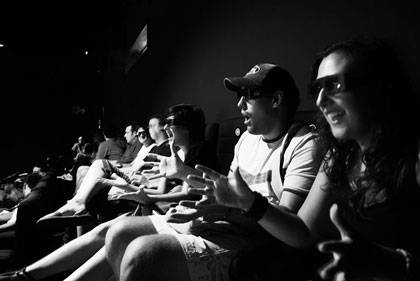
Some film purists may cringe at Hollywood's latest penchant for three-dimensional visual effects, but film theorist Barbara Klinger thinks 3-D is the future of cinematic experience.
Klinger, a film and media studies professor at Indiana University-Bloomington, defended the artistic merits of 3-D cinema last Friday afternoon during her talk, "Beyond Cheap Thrills: Space and Style in Contemporary 3D Cinema."
A free screening of the 3-D dance documentary "Pina" next Friday will complement Klinger's talk. The film will be shown at 7:30 p.m. Friday, March 29, at the North Carolina Museum of Natural Science in Raleigh.
Projecting film scenes and still shots from 3-D films past and present on the massive screen in Richard White Lecture Hall, Klinger discussed arguments for and against 3-D cinema.
"3-D cinema has become one of the most contentious technological developments of 21st century media," Klinger said. "My goal is to move beyond these polarizing terms and pursue a fuller understanding of its elements."
Duke literature professor Markos Hadjiannou, who organized the talk, said Klinger's research on 3-D film is relevant because of the medium's recent box office success. Though often criticized for their commercialism, 3-D effects must be acknowledged as a new form of artistic expression with vast potential, Hadjiannou said.
"It is important for film scholars to understand what is drawing people to 3-D films and why film studios are investing so much in this," Hadjiannou said. "If we look at how movies try to construct their space on screen, 3-D is trying to move away from the 2-D version of space itself and incorporate the body of the audience in the narrative."
Much of Klinger's talk focused on the "pop-out effect," or when characters and props from the film "reach out" into the audience. Klinger said some critics claim it impedes the progress of the narrative. But Klinger said pop-outs, or negative parallax, only draw the audience further into cinematic immersion.
"Films create worlds," Klinger said. "By literally opening up these universes, negative parallax reinforces this world creation. When a dragon's head pops out of the screen during the last 'Harry Potter' film, this reinforces the existence of the fantasy worlds the novels and films have created."
The director of the Program in the Arts of the Moving Image (AMI), Guo-Juin Hong, said the departments would like to include a 3-D film production course by spring 2014.
"We are embracing 3-D," Hong said. "As a program we are interested in examining the commercial success and artistic implications of 3-D cinema."
Film enthusiast and first-year student Megan Rise said she was never that interested in 3-D movies. Now, after listening to Klinger's talk, Rise said, "it sounds like it might be worth a little more experimentation."
For more information on the Arts of the Moving Image program, visit ami.duke.edu.